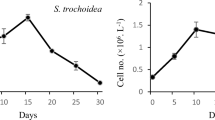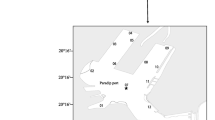Abstract
Compared to planktonic species, there is little known about the ecology, physiology, and existence of benthic dinoflagellates living in sandy beach or seafloor environments. In a previous study, we discovered 132,173-cyclopheophorbide a enol (cPPB-aE) from sand-dwelling benthic dinoflagellates. This enol had never been detected in phytoplankton despite the fact that it is a chlorophyll a catabolite. We speculated from this discovery that habitat selection might be linked to pigment compositions in dinoflagellates. To test the hypothesis of habitat selection linking to pigment compositions, we conducted extensive analysis of pigments with high performance liquid chromatography (HPLC) for 40 species using 45 strains of dinoflagellates including three habitat types; sand-dwelling benthic forms, tidal pool inhabitants and planktonic species. The 40 dinoflagellates are also able to be distinguished into two types based on their chloroplast origins; red alga-derived secondary chloroplasts and diatom-derived tertiary ones. By plotting the pigments profiles onto three habitats, we noticed that twelve pigments including cPPB-aE were found to occur only in benthic sand-dwelling species of red alga-derived type. The similar tendency was also observed in dinoflagellates with diatom-derived chloroplasts, i.e. additional sixteen pigments including chl c 3 were found only in sand-dwelling forms. This is the first report of the occurrence of chl c 3 in dinoflagellates with diatom-derived chloroplasts. These results clarify that far greater diversity of pigments are produced by the dinoflagellates living in sand regardless of chloroplast types relative to those of planktonic and tidal pool forms. Dinoflagellates seem to produce a part of their pigments in response to their habitats.




Similar content being viewed by others
Abbreviations
- cPPB-aE:
-
132,173-Cyclopheophorbide a enol
- PCDi:
-
Pigments common to all dinotoms
- PCPe:
-
Pigments common to all peridinin-type dinoflagellates
- UC:
-
Unknown carotenoid
References
Beale SI (1999) Enzymes of chlorophyll biosynthesis. Photosynth Res 60:43–73
Carreto JI, Carignan MO, Montoya NG (2001) Comparative studies on mycosporine-like amino acids, paralytic shellfish toxins and pigment profiles of the toxic dinoflagellates Alexandrium tamarence, A. catenella and A. minutum. Mar Ecol Prog Ser 49:49–60
Chesnick JM, Kooistra WHCF, Wellbrock U, Medlin LK (1997) Ribosomal RNA analysis indicates a benthic pennate diatom ancestry for the endosymbionts of the dinoflagellates Peridinium foliaceum and Peridinium balticum (Pyrrhophyta). J Eukaryot Microbiol 44:314–320
Choi SS, Cha SH, Tappert CC (2010) A survey of binary similarity and distance measures. J Syst Cybern Inf 8:43–48
Faust MA, Vandersea MW, Kibler SR, Tester PA (2008) Prorocentrum levis, a new benthic species (Dinophyceae) from a mangrove island, Twin Cays, Belize. J Phycol 44:232–240
Fraga S, Rodríguez F, Caillaud A, Diogène J, Raho N, Zapata M (2011) Gambierdiscus excentricus sp. nov. (Dinophyceae), a benthic toxic dinoflagellate from the Canary Islands (NE Atlanic Ocean). Harmful Algae 11:10–22
Green BR (2011) After the primary endosymbiosis: an update on the chromalveolate hypothesis and the origins of algae with Chl c. Photosynth Res 107:103–115
Guillard RR, Ryther JH (1962) Studies of marine planktonic diatoms. I. Cyclotella nana Hustedt, and Detonula confervacea (Cleve) Gran. Can J Microbiol 8:229–239
Herdman EC (1922) Notes on dinoflagellates and other organisms causing discolouration of the sand at Port Erin II. Trans Lpool Bio Soc 36:15–30
Hoppenrath M, Horiguchi T, Miyoshi Y, Selina M, Taylor MFJR, Leander BS (2007) Taxonomy, phylogeny, biogeography, and ecology of Sabulodinium undulatum (Dinophyceae), including an emended description of the species. Phycol Res 55:159–175
Hoppenrath M, Murray SA, Chomérat N, Horiguchi T (2014) Marine benthic dinoflagellates—unveiling their worldwide biodiversity. Schweizerbart, Stuttgart
Horiguchi T, Chihara M (1987) Spiniferodinium galeiforme, a new genus and species of benthic dinoflagellates (Phytodiniales, Pyrrhophyta) from Japan. Phycologia 26:478–487
Horiguchi T, Chihara M (1988) Life-cycle, behavior and morphology of a new tide pool dinoflagellate, Gymnodinium pyrenoidosum sp.nov. (Gymnodiniales, Pyrrhophyta). Bot Mag Tokyo 101:255–265
Horiguchi T, Takano Y (2006) Serial replacement of a diatom endosymbiont in the marine dinoflagellate Peridinium quinquecorne (Peridiniales, Dinophyceae). Phycol Res 54:193–200
Imanian B, Pombert J, Keeling P (2010) The complete plastid genomes of the two ‘dinotoms’ Durinskia baltica and Kryptoperidinium foliaceum. PLoS One 5:e10711
Ito H, Tanaka A (2014) Evolution of a new chlorophyll metabolic pathway driven by the dynamic changes in enzyme promiscuous activity. Plant Cell Physiol 55:593–603
Jeffrey SW, Sielicki M, Haxo FT (1975) Chloroplast pigment patterns in dinoflagellates. J Phycol 11:374–384
Kimura B, Ishida Y (1985) Photophagotrophy in Uroglena americana, Chrysophyceae. Jpn J Limnol 46:315–318
Louda JW, Loitz JW, Rudnick DT, Baker EW (2000) Early diagenetic alteration of chlorophyll-a and bacteriochlorophyll-a in a contemporaneous marl ecosystem; Florida Bay. Org Geochem 31:1561–1580
Ma L, Dolphin D (1999) The metabolites of dietary chlorophylls. Phytochemistry 50:195–202
Mandelli EF (1968) Carotenoid pigments of the dinoflagellate Glenodinium foliaceum Stein. J Phycol 4:347–348
Matsumoto T, Kawachi M, Miyashita H, Inagaki Y (2012) Prasinoxanthin is absent in the green-colored dinoflagellate Lepidodinium chlorophorum strain NIES-1868: pigment composition and 18S rDNA phylogeny. J Plant Res 125:705–711
Murray S, Patterson DJ (2002) The benthic dinoflagellate genus Amphidinium in south-eastern Australian waters, including three new species. Eur J Phycol 37:279–298
Parsons ML, Preskitt LB (2007) A survey of epiphytic dinoflagellates from the coastal waters of the island of Hawai‘i. Harmful Algae 6:658–669
Pienaar RN, Sakai H, Horiguchi T (2007) Description of a new dinoflagellate with a diatom endosymbiont, Durinskia capensis sp. nov. (Peridiniales, Dinophyceae) from South Africa. J Plant Res 120:247–258
Riley JP, Wilson TRS (1967) The pigments of some marine phytoplankton species. J Mar Biol Assoc UK 47:351–361
Saburova N, Al-Yamani F, Polikarpov I (2009) Biodiversity of free-living flagellates in Kuwait’s intertidal sediments. Bio Risk 3:97–110
Sokal RR, Michener CD (1958) A statistical method for evaluating systematic relationships. Kans Univ Sci Bull 38:1409–1438
Takano Y, Hansen G, Fujita D, Horiguchi T (2008) Serial replacement of diatom endosymbionts in two freshwater dinoflagellates, Peridiniopsis spp. (Peridiniales, Dinophyceae). Phycologia 47:41–53
Tamura M, Shimada S, Horiguchi T (2005) Galeidinium rugatum gen. et sp. nov. (Dinophyceae), a new coccoid dinoflagellate with a diatom endosymbiont. J Phycol 41:658–671
Taylor FJR, Hoppenrath M, Saldarriaga JF (2008) Dinoflagellate diversity and distribution. Biodivers Conserv 17:407–418
Tengs T, Dahlberg OJ, Shalchian-Tabrizi K, Klaveness D, Rudi K, Delwiche CF, Jakobsen KS (2000) Phylogenetic analyses indicate that the 19′ hexanoyloxy-fucoxanthin-containing dinoflagellates have tertiary plastids of haptophyte origin. Mol Biol Evol 17:718–729
Wakahama T, Okuyama H, Maoka T, Takaichi S (2012) Unique carotenoid lactoside, P457, in Symbiodinium sp. of dinoflagellate. Acta Biochim Pol 59:155–157
Watanabe MM, Suda S, Inouye I, Sawaguchi T, Chihara M (1990) Lepidodinium viride gen. et sp. nov. (Gymnodiniales, Dinophyta), a green dinoflagellate with a chlorophyll a- and b-containing endosymbiont. J Phycol 26:741–751
Withers NW, Cox ER, Tomas R, Haxo FT (1977) Pigments of the dinoflagellate Peridinium balticum and its photosynthetic endosymbiont. J Phycol 13:354–358
Yamada N, Terada R, Tanaka A, Horiguchi T (2013) Bispinodinium angelaceum gen. et sp. nov. (Dinophyceae), a new sand-dwelling dinoflagellate from the seafloor off Mageshima Island, Japan. J Phycol 49:555–569
Yamada N, Tanaka A, Horiguchi T (2014) cPPB-aE is discovered from photosynthetic benthic dinoflagellates. J Phycol 50:101–107
Zapata M, Rodríguez F, Grarrido JL (2000) Separation of chlorophylls and carotenoids from marine phytoplankton: a new HPLC method using a reversed phase C8 column and pyridine-containing mobile phases. Mar Ecol Prog Ser 195:29–45
Zapata M, Fraga S, Rodríguez F, Garrido JL (2012) Pigment-based chloroplast types in dinoflagellates. Mar Ecol Prog Ser 465:33–52
Zhang ZD, Green BR, Cavalier-Smith T (1999) Single gene circles in dinoflagellate chloroplast genomes. Nature 400:155–159
Zhang Q, Liu G, Hu Z (2011) Morphological differences and molecular phylogeny of freshwater blooming species, Peridiniopsis spp. (Dinophyceae) from China. Eur J Protistol 47:149–160
Zhang Q, Liu G, Hu Z (2014) Description of a new freshwater bloom-forming dinoflagellate with a diatom endosymbiont, Peridiniopsis minima sp. nov. (Peridiniales, Dinophyceae) from China. Algol Stud 146:119–133
Acknowledgments
We gratefully acknowledge Ms. Junko Kishimoto for technical assistance with the HPLC analyses. We also appreciate to Ms. Saeka Takabayashi for cluster analyses of detected pigments. Our thanks go to Dr. Stuart D. Sym for reading the manuscript and collecting No. 39 and 40 of Durinskia sp. We also thank to Dr. Ryuta Terada and Captain M. Uchiyama and the crew of T/S Nansei-maru, Faculty of Fisheries, Kagoshima University, for their kind help in collecting the underwater samples. This work was partly supported by the Grant-in-Aid by the Japan Society for the Promotion of Science (JSPS) (No. 24370034). Eleven of the strains used in this study were collected during the field trips for the project entitled ‘Biodiversity and evolution of algae in the Indo-Pacific: a Japan/South Africa comparison’ (Strategic International Research Cooperative Program) supported by Japan Science and Technology Agency. This research was also supported by JSPS Research Fellowships for young scientists (No. 322).
Author information
Authors and Affiliations
Corresponding author
Electronic supplementary material
Below is the link to the electronic supplementary material.
Rights and permissions
About this article
Cite this article
Yamada, N., Tanaka, A. & Horiguchi, T. Pigment compositions are linked to the habitat types in dinoflagellates. J Plant Res 128, 923–932 (2015). https://doi.org/10.1007/s10265-015-0745-4
Received:
Accepted:
Published:
Issue Date:
DOI: https://doi.org/10.1007/s10265-015-0745-4




